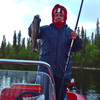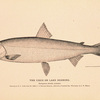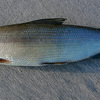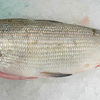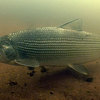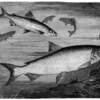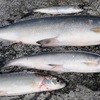Whitefish
-
 European Whitefish (Coregonus lavaretus) Underwater UK
European Whitefish (Coregonus lavaretus) Underwater UK -
 WHITE FISH (Coregonus lavaretus)
WHITE FISH (Coregonus lavaretus) -
 WHITE FISH (Coregonus lavaretus) 29.4.2012
WHITE FISH (Coregonus lavaretus) 29.4.2012 -
 Gutten som trodde det ble ørret men så ble det en Coregonus lavaretus
Gutten som trodde det ble ørret men så ble det en Coregonus lavaretus
Ordinary whitefish (Coregonus lavaretus) is a salmonid fish of Coregonus family. It is a relict fish with its origin in the ice age.
There are many types and forms of whitefish, which are to classify. There can sometimes be 10 or more types in a single water body. The various types of whitefish can easily cross-breed. For most of the types slender, oblong bodies of light shades are characteristic of the species – silver-white or silver-grey sides with darker backs, with mulatto-reddish, green or magenta tones, with milky-white or little greyish bellies. The fins are usually dark even black. The whitefish has no spots on its fins or the rest of the body. This description gave it its English name “Whitefish”.
Its belonging to the salmonid species is due to the small adipose fin. The matting outfit in the shape of epithelial bumps is brighter in the males. The whitefish has a small mouth, without teeth on the vomer and maxilla. Other teeth are either weak or fall out in time. The whitefish’s distinguishing mark is that its upper jaw bone does not exceed the eye-line. Other distinguishing marks include the change in the placement of mouth, which changes from nearly terminal to typically caudal, depending on the type and form. You can also identify a snout tip area, which is taller than its width.
The whitefish likes transparent and oxygen rich water and is known as a flocking fish. The flocks are usually comprised of fish from the similar age group, although they can be various in sizes. The difference in size is due to the fact that the fish swimming at the head of the flock have more chances of feeding than the ones in the tail of the flock.
Talking of food, we must notice that the whitefish eats everything found in the water. Mainly it is all types of crustaceans, amphipods, various types of planktons, shell-fish, worms, young fish and insect larvae. The whitefish with large amounts of gill rakers eat planktons and in rare cases sediment dwellers.
The whitefish also looks for insects, which fall into the water. It is rare that the whitefish would eat the spawn of other fish or its own spawn.
The adult whitefish is a typical predator, which in way cedes in gluttony, for example to pike. But unlike the pike, the whitefish cannot swallow everything that it finds, because of the mouth size, however, as per attacks on young ones, it probably does not cede to the pike.
The Upper-Tuloma reservoir houses the typical lake type whitefish, which lives and spawns in the same lake. The lake type whitefish eats off the bottom of the lake and grows very rapidly. But there is also the lake-river type or Siberian-whitefish, which is the largest in size. Just like the Omul it spawns in the rivers and is a distant relative of the same.
The whitefish starts to spawn at an age of 4-6 years, usually late in the autumn or in the beginning of winter when the water temperature is as low as 4-6OC. the rate of productivity of the whitefish depends on the size and varies from 4 to 80 thousand eggs, but on average the number is 20-30 thousand. The incubation period spans over the winter, till the melting of ice and takes 190-210 days. They spawn in pebbly bed areas or on rocky shallow, most commonly in still water. The females do not sit the spawn. The whitefish spawn is commonly small in size and bright-orange in colour.
The whitefish’s lifespan is up to 20 years, but most commonly fished pcs are in the age group of 7-10 years.
The whitefish can vary in size depending on the type. The smaller types do not grow longer than 15cm, but the larger ones grow as long as 60cm and weigh up to 2 kg.
Since the Upper-Tuloma reservoir is filled with European cisco and candle fish, which is eaten by the whitefish, therefore extraordinary trophy catch can go as high as 5 to 8 kg. The heaviest whitefish was caught in neighbouring Finland: 12 kg.
The whitefish can be fished all year round – in summer we mostly use floating tackle (medium spoon bait with a sandwich of gadfly and worm). In winter we use spoon bait with gadfly. In summer it is also possible to use the flyfishing technique for the whitefish or using a bombarda (sbirulino). It is possible to fish for whitefish with a spinning, but it is tough. When using a spinning we must use ultra-light spinning, which can handle small bait – micro-wobblers, blinkers painted blue and small red (copper) spinner, like “Blue Fox” № 2, 3, imitating insects.
Whitefish is very tasty from the culinary point of view. Its meat is soft, fat and tasty, especially when we talk about the larger types. A properly cooked whitefish can be as good as many types of salmon.
At present the population of whitefish is declining in many areas of the Russian federation, due to the construction of dams, due to deterioration of ecological conditions, fishing pressure and the state’s inaction against pouching. Some types of whitefish are already included in the Red Book. However, in the hard to reach Russian Lapland areas, there is ample catch still in many waterways.
